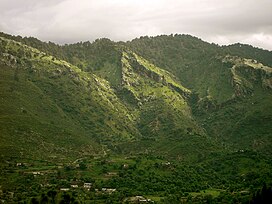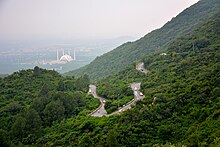geo.wikisort.org - Mountains
The Margalla Hills (Urdu: مارگلہ پہاڑیاں) are a hill range within the Margalla Hills National Park on the northern edge of Islamabad Capital Territory, Pakistan, just south of Haripur District, Khyber Pakhtunkhwa. They are part of the Himalayan foothills. The Margalla range has an area of 12,605 hectares.[1] It is a range with many valleys as well as high mountains.
| Margalla Hills | |
|---|---|
 Margalla Hills | |
| Highest point | |
| Peak | Tilla Charouni |
| Elevation | 1,604 m (5,262 ft) |
| Coordinates | 33°46′33.7506″N 73°7′26.4822″E |
| Naming | |
| Native name | مارگلہ پہاڑیاں |
| Geography | |
 Islamabad, Pakistan | |
| Country | |
| Range coordinates | 33°44′40″N 73°2′30″E |



Infrastructure

Khayaban-e-Iqbal, arises on the north east side from the 4th Avenue (Nur Pur Shahan), runs between E and F sectors, and ends at Service Road West of F-11 and E-11 (Golra) sectors in the south-east. It will be extended up to Grand Trunk (GT) Road in the near future.[2]
Paleontology and archeology
According to the research carried out by scientists and archaeologists of the project "Post-Earthquake Explorations of Human Remains in Margalla Hills", the formation of the Margalla Hills dates to the Miocene epoch. The dominant limestone of the Margalla is mixed with sandstone and occasional minor beds of shale. The archaeologists of the project have also found two human footprints over one million years old here, preserved in sandstone.[3]
Flora and fauna


There are around 250 to 300 species of plants on the Margalla Hills. As many as two-thirds of them are used by the people for their medicinal effects to treat or cure various diseases.[4]
The Margalla Hills are home to various species of wildlife, including monkeys, exotic birds and carnivores such as the rare and presently endangered Margalla leopard.[5]
Much less common are leopards, which occasionally come down from the Murree area but usually remain high up in the hills. Villagers dwelling in the Margallas do report sighting of leopards off and on.[6]
Recreation

Bird watching
The Margallas are an excellent place for bird watchers. The area is home to a large number of birds, including robins, sparrows, kites, crows, larks, paradise flycatchers, black partridge, shrikes, pheasants, spotted doves, Egyptian vultures, falcons, hawks, eagles, Himalayan griffon vulture, laggar falcon, peregrine falcon, kestrel, Indian sparrow hawk, white cheeked bulbul, yellow vented bulbul, paradise flycatcher, cheer pheasant, Khalij pheasant, golden oriole, spotted dove, collared dove, wheatears and buntings.[5]
The cheer pheasant, indigenous to the Khyber Pakhtunkhwa, was being reared in Margalla Hills as a part of conservation campaign by the World Pheasant Association and Capital Development Authority.[7]
Hiking trails
There are several hiking trails in the Margalla Hills.[8] Trail 3 and 5 are the most popular ones, starting from the Margalla Road opposite sector F-6 and ending at the Pir Sohawa Road.
Environmental conservation

The ecology of Margallas faces threats from quarrying by stone-crushing plants,[9] deforestation,[10] illegal encroachments,[11] and buildings, and poachers.[12] Crush plants situated around the hills near Taxila are busy eroding the hills for extracting building material.[13] Deforestation is resulting from fires and illegal felling of trees.[14]
Margalla Hills Society
The Margalla Hills Society[15][16] was established in 1989.[17][18]
World Wildlife Fund (WWF) Pakistan
The WWF-Pakistan's 'Green School Programme', in collaboration with the Capital Development Authority (CDA), carries out 'Eco-Adventure Activities' on the Margalla hills to raise awareness in the school children regarding the conservation of natural environment and about the importance of being environmentally responsible.[19]
Events
- On 28 July 2010, Airblue Flight 202 crashed in the Margalla Hills.[20]
- On 6 January 2012, snowfall over Margalla Hills.[21]
- On 11 February 2016, snowfall over Margalla Hills.[22]
Places in Margalla Hills
- Daman-e-Koh
- Pir Sohawa
- Shahdara, Islamabad
See also
- Margalla Hills National Park
- Birds of Islamabad
- Airblue Flight 202
- Faisal Mosque
References
- "Another fire breaks out on Margalla Hills". Dawn. 2021-05-27. Retrieved 2022-02-26.
- Virk, Mobarik A. (9 May 2021). "Work on Margalla Avenue likely to start in 6 months". The News International. Retrieved 2022-02-26.
- "1m-years-old footprints found at Margalla Hills". Dawn. 2007-07-28. Retrieved 2022-02-26.
- "64 per cent plants on Margalla Hills used for treatment of diseases - thenews.com.pk". The News International. 2012-12-17. Archived from the original on 17 December 2012. Retrieved 2022-02-26.
- "Margalla Hills National Park". Wildlife of Pakistan. Retrieved 2017-05-23.
- Azeem, Munawer (2015-12-24). "Leopards seen on Margalla Hills". Dawn. Retrieved 2022-09-22.
- "Cheer pheasant reintroduced successfully into the wild". The Express Tribune. 2021-11-06. Retrieved 2022-02-23.
- "Trails - Islamabad". Capital Development Authority. Retrieved 2022-03-06.
- Anwar, Shahzad (2014-12-28). "Environmental hazard: Stone-crushing plants nibbling away Margallas". The Express Tribune. Retrieved 2022-02-23.
- Anjum, Shakeel (11 September 2018). "Encroachers causing deforestation on Margalla Hills". The News International. Retrieved 2022-02-23.
- Iqbal, Nasir (2021-11-10). "IHC orders survey of damage caused to Margalla Hills National Park". Dawn. Retrieved 2022-02-23.
- "Experts call for halt to poaching of pangolin". The Express Tribune. 2022-01-30. Retrieved 2022-02-23.
- "Stone crushers pose threat to Margallas: World Earth Day observed". Dawn. 2009-04-23. Retrieved 2022-09-22.
- "CDA fails to control Margalla Hills fire". Daily Times (Pakistan)|Daily Times]]. 2013-12-03. Archived from the original on 3 December 2013. Retrieved 2022-02-26.
- "Roedad Khan - Margalla Hills Society". Roedad.com. Retrieved 2017-05-23.
- Khan, Aurangzaib (2015-02-25). "Herald Exclusive: The whole Roedad". Dawn. Retrieved 2022-02-23.
- Salam, Afia (2013-10-07). "A tunnel without vision". Dawn. Retrieved 2022-02-23.
- "PM's intervention sought to halt work on Margalla Road". Dawn. 2021-12-20. Retrieved 2022-02-23.
- "Eco-adventure activity launched on Margalla Hills - thenews.com.pk". The News International. 2012-12-26. Archived from the original on 26 December 2012. Retrieved 2022-02-26.
- Crilly, Rob (28 July 2010). "Passenger plane crashes outside Islamabad". The Daily Telegraph. London. Retrieved 28 July 2010.
- "Margalla Hills receive snowfall after 6 years". 2013-12-02. Archived from the original on 2 December 2013. Retrieved 2022-02-26.
- "Margalla Hills turn snowy after a decade". Dawn. 2016-02-11. Retrieved 2022-09-22.
На других языках
[de] Margalla Hills
Die Margalla Hills sind ein Gebirge im Norden Islamabads in Pakistan. Es liegt hinter der Faisal-Moschee, der größten Moschee der Welt, und eignet sich besonders zum Wandern oder zum Besichtigen der Stadt. Die beste Zeit hierfür ist der Winter, wenn wenig Regen fällt und die Tage von der Temperatur her angenehmer sind.- [en] Margalla Hills
[it] Colline di Margalla
Le colline di Margalla (note anche come Margalla Hills; .mw-parser-output .urdu{font-family:"Jameel Noori Nastaleeq","Mehr Nastaliq Web","Alvi Lahori Nastaleeq","Alvi Nastaleeq","Nafees Nastaleeq","Nafees Nastaleeq v1.01","Noto Nastaliq Urdu","Pak Nastaleeq","Urdu Emad Nastaleeq",PDMS_Jauhar,"Urdu Typesetting",Nafees,IranNastaliq,Amiri,Georgia,"Times New Roman",Times,sans-serif;font-size:120%}in urdu: مارگلہ پہاڑیاں) sono una serie di colline situate a nord di Islamabad, in Pakistan. Si innalzano proprio dietro alla Moschea Faisal, la più grande del mondo, e sono particolarmente adatte per effettuare escursioni o per trovare un po' di sollievo dal caos della capitale. Il momento migliore per le visite è l'inverno, quando cade meno pioggia e le giornate sono caratterizzate da temperature più miti. Queste colline sono attraversate dalla Grand Trunk Road.[ru] Маргалла (холмы)
Холмы Маргалла, также известные как Горный хребет Маргалла или просто Маргалла, — невысокий горный хребет, являющийся частью Малых Гималаев и расположенный к северу от Исламабада (столицы Пакистана). Площадь хребта Маргалла составляет 12 605 гектаров. Холмы являются частью холмов Murree. Хребет включает в себя множество как долин, так и высоких вершин.Другой контент может иметь иную лицензию. Перед использованием материалов сайта WikiSort.org внимательно изучите правила лицензирования конкретных элементов наполнения сайта.
WikiSort.org - проект по пересортировке и дополнению контента Википедии